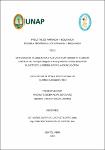| dc.contributor.advisor | De la Cruz Flores, Mario Javier | |
| dc.contributor.advisor | García de Sotero, Dora Enith | |
| dc.contributor.author | Alva Ochavano, Magaly Eusebia | |
| dc.contributor.author | Golac Linares, Gessica Jhoana | |
| dc.date.accessioned | 2022-09-26T18:01:28Z | |
| dc.date.available | 2022-09-26T18:01:28Z | |
| dc.date.issued | 2022 | |
| dc.identifier.uri | https://hdl.handle.net/20.500.12737/8372 | |
| dc.description.abstract | Antioxidants have the ability to protect biological systems against reactions that can produce potentially harmful effects, such as reactive oxygen species (EROS or ROS). The objective was to determine secondary metabolites by spectrophotometric methods and in vitro antioxidant activity of the bark of Cecropia strigosa Trécul and Matisia cordata Bonpl by the DPPH method. The samples were conditioned, dried in a dehumidifier at 40°C for seven days, sprayed. In phenolic compounds, C. strigosa Trécul presented 14940.562 mg/100g in total phenols; flavonoids 21,027 mg/100g; anthocyanins 13.073 mg/100g and catechins 0.002 mg/100g; M. cordata Bonpl 19842.523 mg/100g in total phenols; flavonoids 31,842mg/100g; anthocyanins 13.880 mg/100g and catechins 0.004 mg/100g. For Alkaloids, C. strigosa Trécul presented 23.14 mg/100g; while M. cordata Bonpl 37.42 mg/100g. For Saponins, C. strigosa Trécul 178.620 mg/100g and M. cordata Bonpl 442.110 mg/100g. The antioxidant activity of C. strigosa Trécul showed inhibition percentages of 19.65%, 33.71%, 39.54%, 42.16%, 45.72%, 94.29%; while M. cordata Bonpl showed 32.97%, 61.54%, 83.53%, 89.49%, 98.14% and 98.57% at concentrations of 1, 2, 4, 8, 16 and 25 mg/mL respectively. M. cordata Bonpl, compared to C. strigosa Trécul, showed a better result in IC50, because it obtained the lowest value (1.46 mg/mL) compared to the IC50=16.79mg/mL of C. strigosa Trecul; being identified, as well as the one with the best antioxidant activity in vitro. | en_US |
| dc.description.abstract | Los antioxidantes tienen la capacidad de proteger los sistemas biológicos contra reacciones que pueden producir efectos potencialmente dañinos, como las especies reactivas del oxígeno (EROS o ROS). El objetivo fue determinar metabolitos secundarios por métodos espectrofotométricos y actividad antioxidante in vitro de corteza de Cecropia strigosa Trécul y Matisia cordata Bonpl por el método DPPH. Las muestras fueron acondicionadas, secadas en deshumecedor a 40°C por siete días, pulverizadas. La especie C. strigosa Trécul presentó 14940,562 mg/100g de fenoles totales; flavonoides 21,027 mg/100g; antocianinas 13,073 mg/100g y catequinas 0,002 mg/100g; M. cordata Bonpl 19842,523 mg/100g en fenoles totales; flavonoides 31,842 mg/100g; antocianinas 13,880 mg/100g y catequinas 0,004 mg/100g. Para Alcaloides, C. strigosa Trécul presentó 23,14 mg/100g y M. cordata Bonpl 37,42 mg/100g, Para Saponinas, C. strigosa Trécul 178,620 mg/100g y M. cordata Bonpl 442,110 mg/100g. La actividad antioxidante de C. strigosa Trécul mostró porcentajes de inhibición de 19,65%, 33,71%, 39,54%, 42,16%, 45,72%, 94,29%; mientras que M. cordata Bonpl mostró 32,97%, 61,54%, 83,53%, 89,49%, 98,14% y 98,57% a concentraciones de 1, 2, 4, 8, 16 y 25 mg/mL respectivamente. M. cordata Bonpl, en comparación con C. strigosa Trécul, mostró una mejor actividad antioxidante in vitro con un menor valor de IC50 de 1,46 mg/mL; en comparación con la IC50=16,79mg/mL de C. strigosa Trécul. | es_PE |
| dc.format | application/pdf | es_PE |
| dc.language.iso | spa | es_PE |
| dc.publisher | Universidad Nacional de la Amazonía Peruana | es_PE |
| dc.rights | info:eu-repo/semantics/openAccess | * |
| dc.rights.uri | https://creativecommons.org/licenses/by/4.0/ | * |
| dc.subject | Antioxidante | es_PE |
| dc.subject | Corteza | es_PE |
| dc.subject | Cecropia strigosa | es_PE |
| dc.subject | Matisia cordata | es_PE |
| dc.subject | In vitro | es_PE |
| dc.subject | Equipo de laboratorio | es_PE |
| dc.title | Metabolitos secundarios y actividad antioxidante in vitro de corteza de Cecropia strigosa Trécul y Matisia cordata Bonpl por el método 1,1-difenil-2-picril-hidrazilo-DPPH | es_PE |
| dc.type | info:eu-repo/semantics/bachelorThesis | es_PE |
| thesis.degree.discipline | Farmacia y Bioquímica | es_PE |
| thesis.degree.grantor | Universidad Nacional de la Amazonía Peruana. Facultad de Farmacia y Bioquímica | es_PE |
| thesis.degree.name | Químico(a) Farmacéutico(a) | es_PE |
| dc.subject.ocde | https://purl.org/pe-repo/ocde/ford#3.01.05 | es_PE |
| renati.author.dni | 71928688 | |
| renati.author.dni | 70600483 | |
| renati.advisor.orcid | https://orcid.org/0000-0003-2212-3936 | |
| renati.advisor.orcid | https://orcid.org/0000-0002-9501-1372 | |
| renati.advisor.dni | 40553043 | |
| renati.advisor.dni | 05236520 | |
| renati.type | https://purl.org/pe-repo/renati/type#tesis | es_PE |
| renati.discipline | 917046 | es_PE |
| renati.level | https://purl.org/pe-repo/renati/level#bachiller | es_PE |
| renati.juror | Ruiz Vásquez, Liliana | |
| renati.juror | Jara Herrera, Cleto | |
| renati.juror | Alvarez Marreros, Roy Alexander | |
| dc.publisher.country | PE | es_PE |


